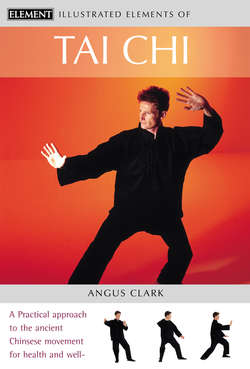Читать книгу Tai Chi: A practical approach to the ancient Chinese movement for health and well-being - Angus Clark - Страница 15
ОглавлениеStability and Mobility
HERE, WITH THE HELP of two guided exercises, you can develop a practical understanding of the qualities of stability and mobility. Let your feet meet the earth. Let your knees follow the direction of your toes. Soften your hips. Let your pelvis float and your spine anchor you in the earth and carry you to the sky. These injunctions are the basis of stability and the key to understanding the nature of tai chi movement, for the body’s relationship to the earth is like that of an underwater plant, which is anchored to a rock yet moves with ease in the current.
Many people who begin tai chi are not used to maintaining a low center of gravity, or to using their legs so much. Aching legs are a sign that tai chi is gradually strengthening the limbs. The process works in two ways, so it is through the movements that a beginner develops stability. Trying to deepen the stance by dropping the spine while moving accustoms the legs to work harder and makes it possible to achieve a still lower center of gravity.
This exercise in stability begins with the principles expressed in the posture Stand Like A Mountain Between Heaven and Earth. It ensures every stance or movement is rooted to the earth, but reaches up to the heavens.
STABILITY
This is a two-person exercise, although the role of your partner is to act as an assistant. Ask your partner to build up the pressure very gradually as you learn to deal with it. Before you begin, find the position Stand Like a Mountain Between Heaven and Earth, and take a moment to relax into it.
1 When you are feeling comfortably stable and your body has a sense of wholeness, ask your friend to lean in toward you from the side, gently and slowly.
2 Drop your spine slightly and let your arms move a few inches out to the sides, meeting the weight leaning against you and channeling it into the earth. If your partner leans too heavily against you, you may have to hold off the force with your arm. This should not happen, so rest and begin again.
3 As you become familiar with the feeling of the weight of another body leaning into you from the side and channeling down through your body, ask your friend to roll around you slowly and lean into you from different angles. Notice how you have to make slight changes to your frame to adjust to pressure from different angles.
4 Remain solidly stable as your partner turns while orbiting around you.
MOBILITY
For this exercise you need a safe, comfortable space to move in, and a blindfold. Play some of your favorite, soothing music. While doing this exercise you will be blindfolded, so you will not be able to read these directions at the same time. Rather than try to memorize them, record yourself reading them or ask a friend to read them out to you. Take your time with this exercise. It will probably last 10 to 20 minutes, but there is no time limit. You may find yourself drawn into the meditation for as long as an hour.
1 Stand, blindfolded, imagining you hold a ball of light in your hands. Play with it for a minute. Now imagine the light pouring from the ball into your hands and wrists. Imagine the light soothing and oiling the joints, and massaging your hands and wrists.
2 Invite the light to move up through your arm bones into your elbows, bringing them freedom of movement. Feel the folding, unfolding, and turning movements of this complex joint, and its link to wrists and hands.
3 Follow the light up your arms and pouring into your shoulder joints. Move your arms forward and back, up and down, and out to the sides, exploring their mobility. Think about how each limb is connected from shoulder to finger joint.
4 Feel the light flood from your shoulder joint into your shoulder blades and move to your neck. Relaxing your face and jaw, move your neck in every direction. Then follow the light as it moves up into your jaw and skull. Explore the movement of your jawbone.
5 The light slowly descends your spine, filling each vertebra and spreading along each rib. Explore the movement possibilities of your upper body. Follow the light down to the sacrum and coccyx. As it circles the pelvic girdle, your hips join the dance. Let yourself move intuitively and creatively.
6 Let the light pour into your hip joints, directing your attention to them and supporting their movement. Listen to your pelvis and follow the knowledge that resides in it.
7 Follow the light down each thighbone. Your knees fill with light. It pours down your shin bones to your ankles and feet. Your whole frame is alight and alive, a dancing skeleton.
8 Bring your body to rest. You may feel like standing or sitting, crouching, squatting, crawling, or even rolling on the floor. Notice your mobility as you move into these different positions. Finish by resting in any position for at least one minute. Remove your blindfold.
